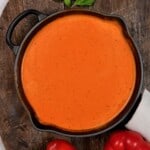The Best Roasted Red Pepper Sauce
This rich and creamy roasted red pepper sauce is ready in under 30 minutes and is a great alternative to tomato-based sauces. Enjoy it as a pasta sauce, sauce for proteins, dip, drizzle, or spread.
Servings: 4
Equipment
Ingredients
- 16 oz roasted red peppers 1 jar
- 1/2 cup heavy cream (double cream)
- 2 Tbsp butter
- 1/2 Tbsp garlic minced
- 1/2 tsp dried oregano
- 1/4 tsp sea salt
- 1/4 tsp black pepper
Instructions
- Transfer the roasted peppers to a blender and add 1-2 Tbsp of the liquid from the jar. Blend until smooth.
- Melt the butter in a large skillet over medium-low heat. Then add the minced garlic and cook for 1-2 minutes until the garlic is fragrant.
- Add the blended roasted peppers and the spices (oregano, pepper, salt) and stir to combine. Let the sauce simmer and lower the heat. Cook for a further 10-15 minutes until the sauce reduces a bit and becomes thicker.
- Add the cream, stir to combine, and taste test. If needed, adjust the seasoning to your liking. Enjoy!
Notes
To store: Allow the sauce to cool, then store it in an airtight container in the fridge for up to a week.
To freeze: It’s best to do so without cream. Transfer the sauce to an airtight freezer-safe container or Ziplock bag (with all the air removed) and store for up to one month. Thaw in the fridge overnight OR place the bag/container in warm water for 25-30 minutes before reheating.
To reheat: Do so gently on the stovetop or in the microwave, stirring well to combine it. If the sauce thickens up while storing, add an extra splash or two of milk, cream, or water to bring it back to your desired consistency.
Check the blog post for serving suggestions!
Nutrition
Serving: 0.5Cup | Calories: 176kcal | Carbohydrates: 6g | Protein: 2g | Fat: 17g | Saturated Fat: 11g | Polyunsaturated Fat: 1g | Monounsaturated Fat: 4g | Trans Fat: 0.2g | Cholesterol: 49mg | Sodium: 1754mg | Potassium: 205mg | Fiber: 2g | Sugar: 1g | Vitamin A: 1216IU | Vitamin C: 53mg | Calcium: 75mg | Iron: 1mg
